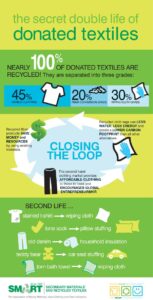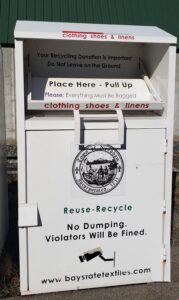 Don’t throw out those tattered jeans! As of Nov. 1, 2022, clothing and textiles are no longer allowed to be thrown away in the trash in Massachusetts, as the state moves to drastically reduce its solid waste. Why this textile ban? According to the Mass. Dept. of Environmental Protection, over 230,000 tons of textiles are thrown away each year in Massachusetts, and about 85 percent of those textiles could be donated, reused, or recycled instead.
Don’t throw out those tattered jeans! As of Nov. 1, 2022, clothing and textiles are no longer allowed to be thrown away in the trash in Massachusetts, as the state moves to drastically reduce its solid waste. Why this textile ban? According to the Mass. Dept. of Environmental Protection, over 230,000 tons of textiles are thrown away each year in Massachusetts, and about 85 percent of those textiles could be donated, reused, or recycled instead.
Most of us are good about donating gently used clothing, but — tattered jeans? Stained shirts? Threadbare socks? And what about shoes, belts, curtains and sheets, towels, stuffed animals? As long as textiles are not wet, moldy, or contaminated, they can all go into the Collection Bins. Many donated textiles can be reused, and those that cannot be reused are re-purposed for use in insulation, carpet padding, soundproofing material, and industrial wiping cloths, among other things.
It’s Easy! There are many places to donate clothing and textiles locally, so compliance with the textile ban will be easy. Both non-profit and for-profit ventures will be needed to handle the expected increase in clothing donations.
Needham residents with an RTS sticker may drop off clothing and textiles at the Red Cross container or the Bay State Textile container. All types of textiles, including clothing, shoes, undergarments, belts, stuffed animals, curtains and linens, are acceptable, as long as they are not wet, mildewed, or contaminated. You can put footwear — sports shoes, cleats, boots, flip flops, and more– in the containers. They do not have to be wearable and single shoes are acceptable. For more information, the RTS website has a link to these FAQs.
More places to drop off textiles. There are also textile drop-off collection boxes located in Needham center and several local places that accept gently-used clothing. See the Needham Recyclopedia for a complete listing.
Beyond the Ban. Realistically, a truly sustainable, circular system of textile recycling and reuse will only be possible if we reduce the amount of textiles used in the first place. According to the EPA, the amount of clothing and footwear generated in the US doubled between 2000 and 2018, from 6 1/2 million tons to 13 million tons. Manufacture of textiles is hard on the environment, with “high energy, water and chemical use, the generation of textile waste and microfibre shedding into the environment during laundering. . . . Textiles’ ecological footprint has been exacerbated by the growth of fast fashion – cheaply manufactured, low quality clothing designed to be trendy and purchased frequently.”1
What can we do? Avoid purchasing cheap, made-to-be-discarded clothing. Instead, buy fewer, more long-lasting products. Buy some of your clothing second hand — if people abide by the textile waste ban, there will be more used clothing to be sold and more choices for consumers. Buying used clothing helps to keep the cycle of use and reuse moving.
1. Mini Review Article. Front. Environ. Sci., 05 September 2022
Sec. Toxicology, Pollution and the Environment
https://doi.org/10.3389/fenvs.2022.973102


